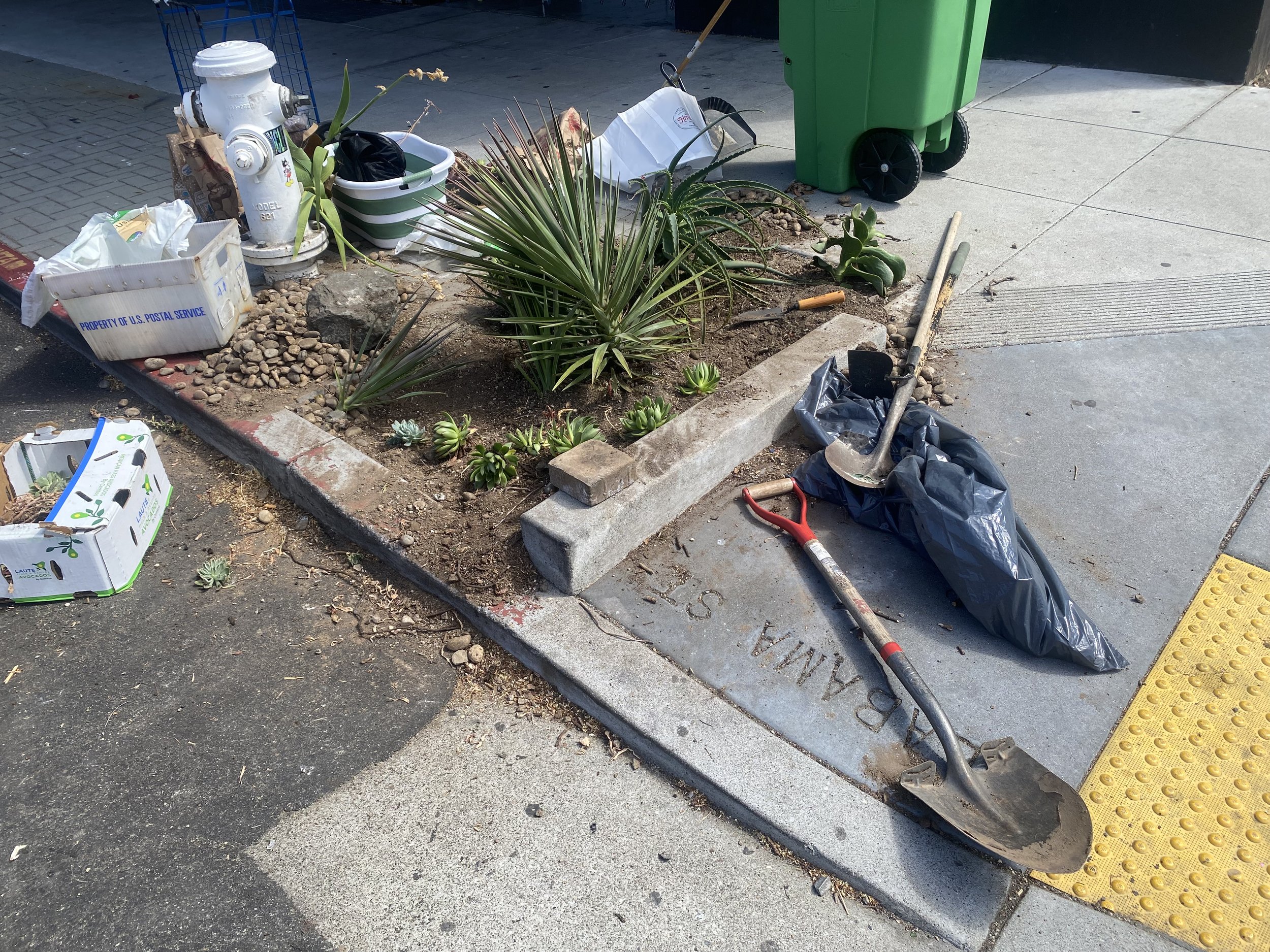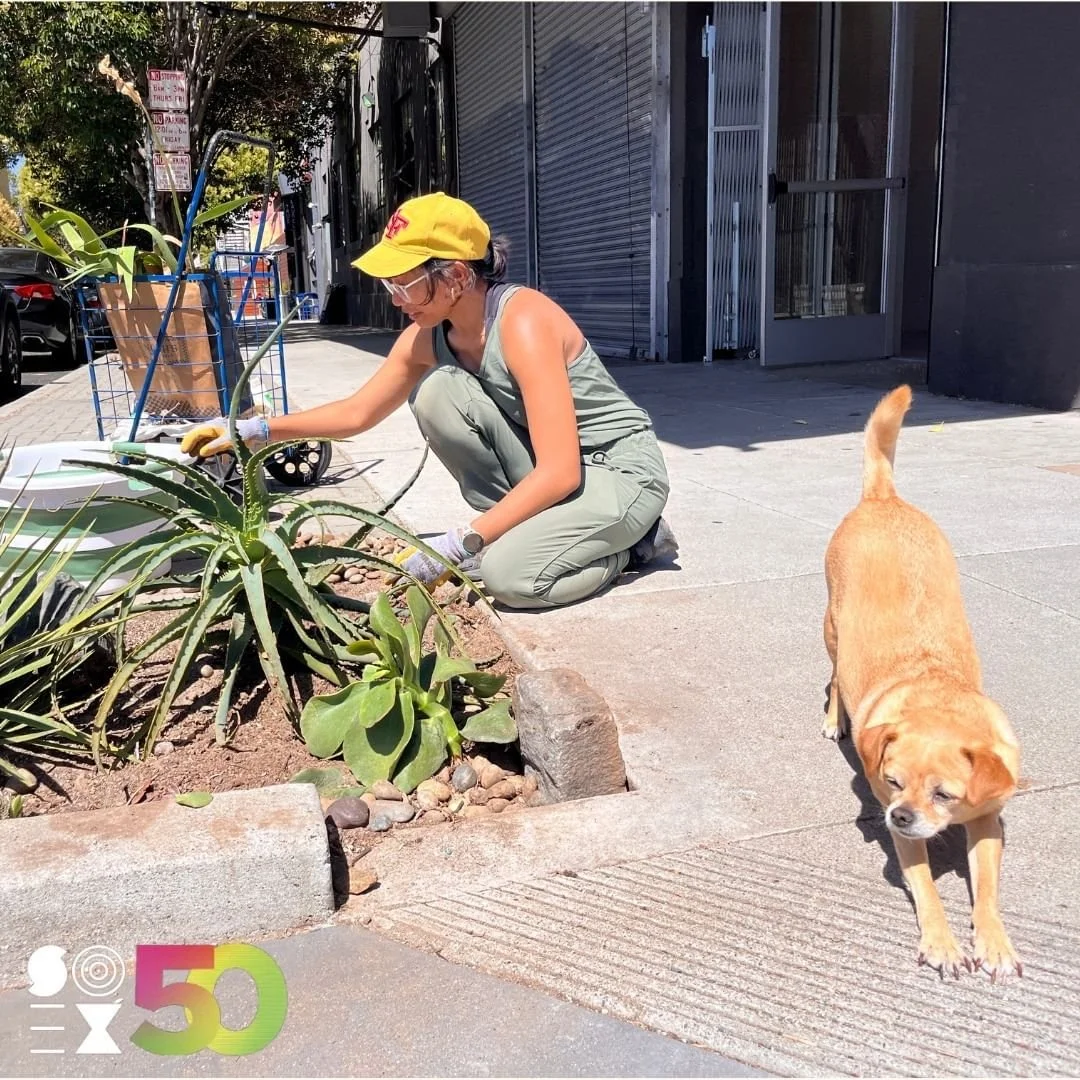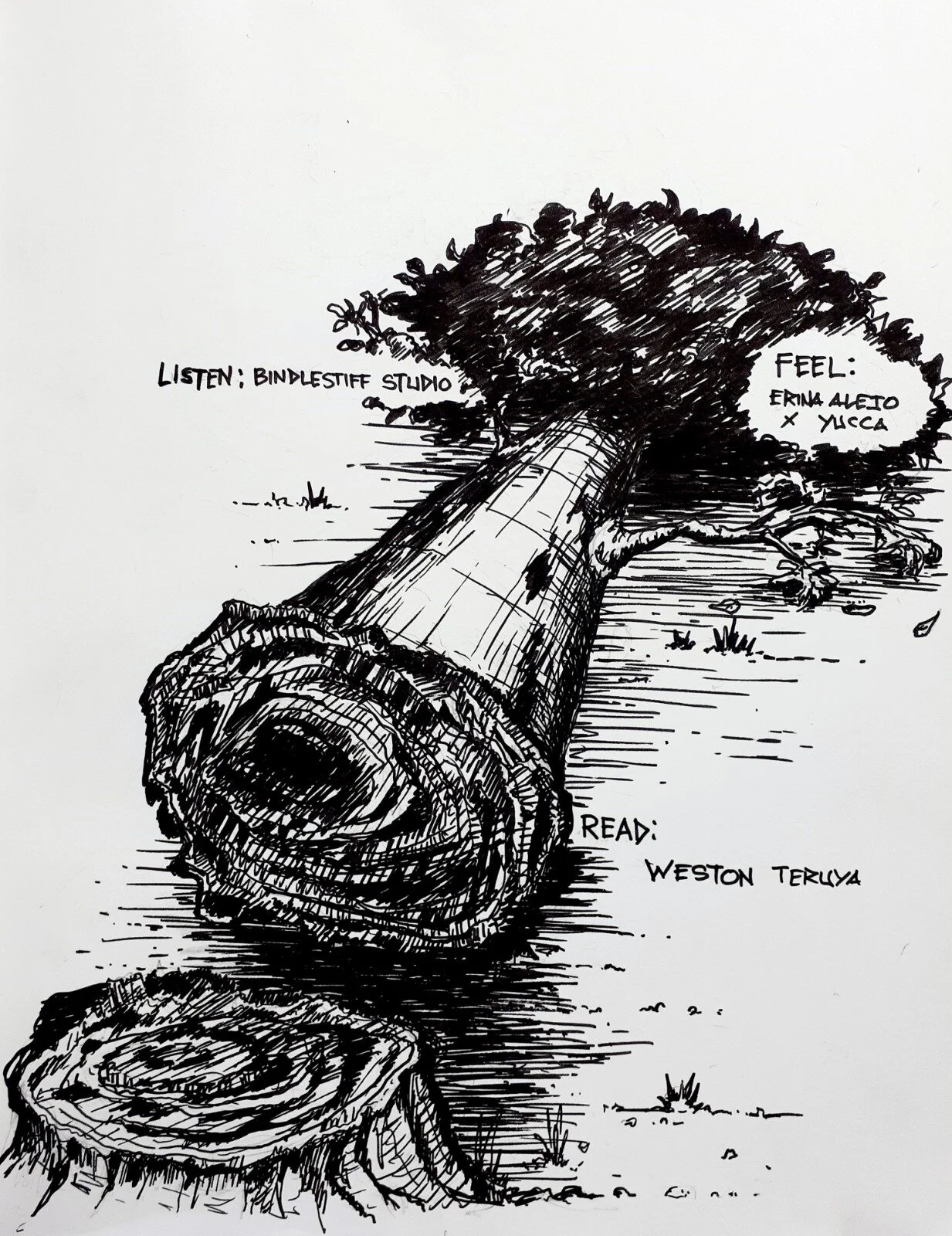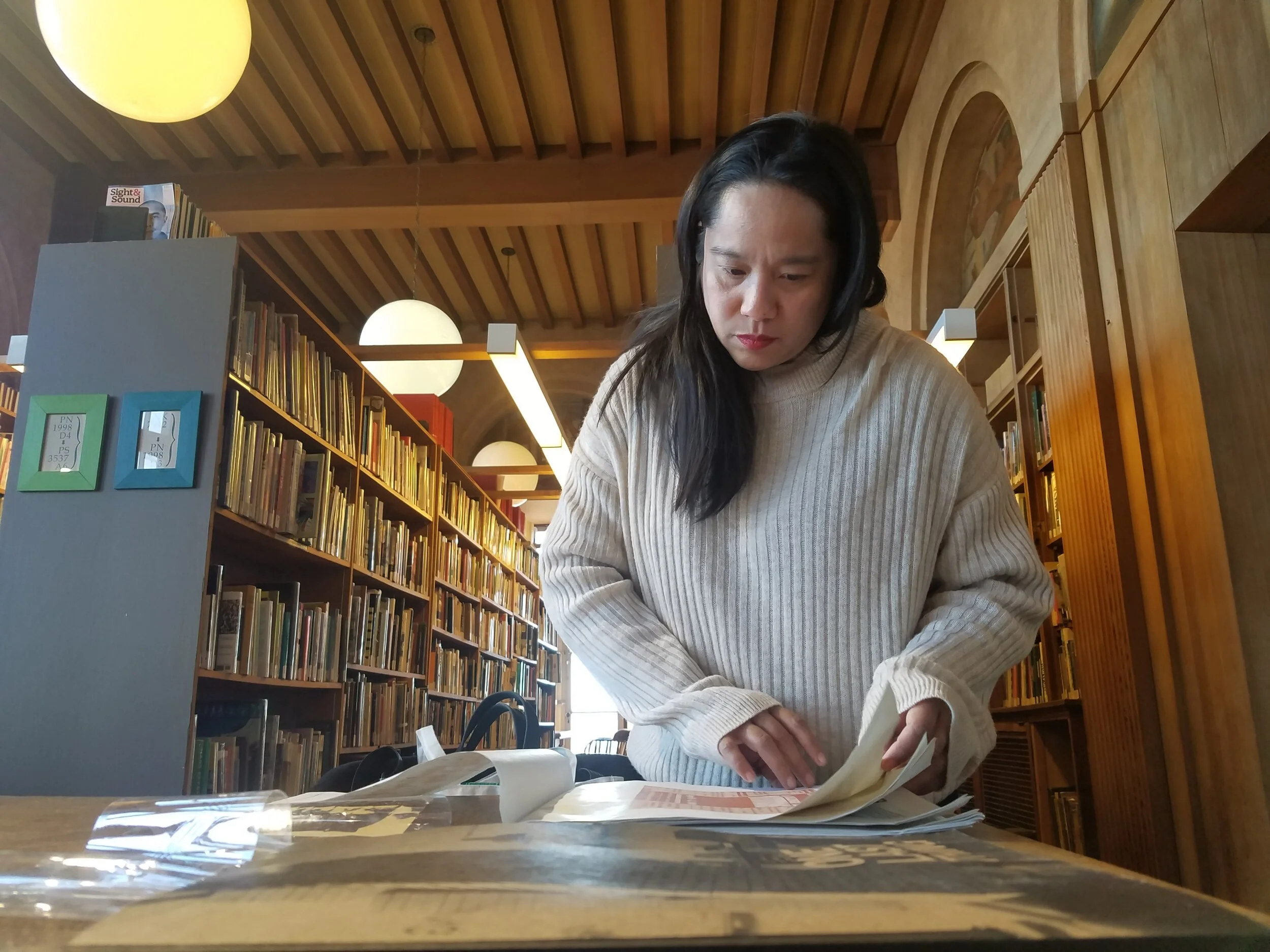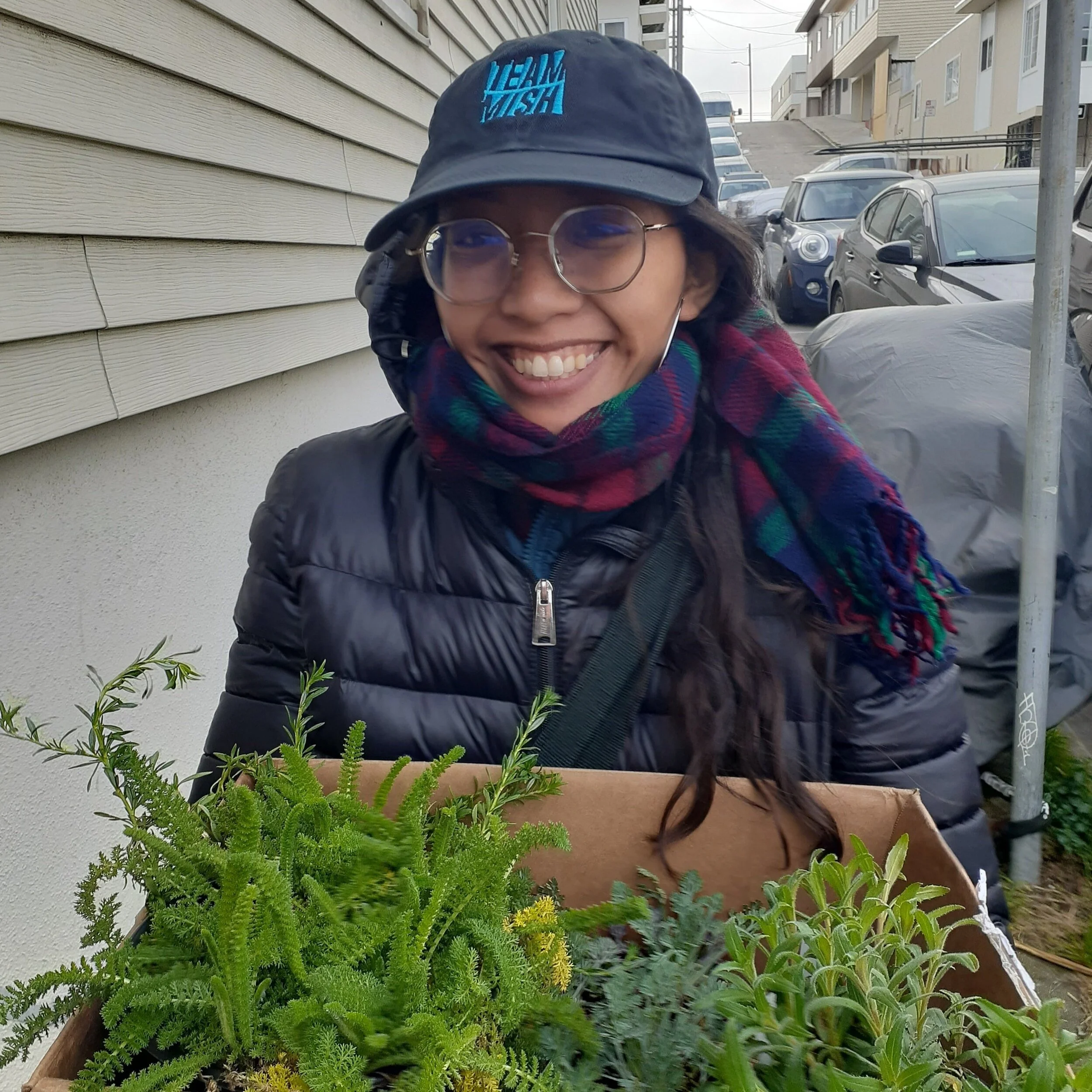
PLANTS HAVE FEELINGS
Culturally Significant Plants Amplify QTBIPOC Resilience Against Displacement
Planting plants at the plot in front of Southern Exposure, 2024
♥ archival research
♥ plant oral histories
♥ shifting perspectives
of map-making
♥ community love
Erina at the SOEX plot with Clemmy, photo by Val Imus, 2024
Iterations
2024
Collaborators: Elder community gardener William Collins and Southern Exposure
Activities: Planting, photography, installation, publication, and mutual aid for Southern Exposure’s 50th Anniversary
Community raised mutual aid to buffer William’s lost income when he does not work outside with the plants and landscape on rainy days.
2020
Collaborators: Lian Ladia, Plant Oral History Mapping Participants
Activities: Mapping crowd-sourced plant oral histories in San Francisco’s South of Market, Mission, and Excelsior Districts
William Collins by Erina Alejo, 2024
Mutual aid GoFundMe campaign for William, 2024
In March 2020, San Franciscans sheltered in place in response to the COVID-19 pandemic. Households found themselves in close quarters with their roommates, family members, existential thoughts, essential items, and house plants. In the Mission, Excelsior, and South of Market—where Black, brown, and immigrant families have built histories over the past century—we asked a simple question:
Which plants accompany us in our gardens and communities, providing grounding and a homelike atmosphere?
This project offered a glimpse into the companionship between plants and humans—often unappreciated or unnoticed. Plants provide a calming and healing presence in our daily urban lives amidst existential reflections on issues not limited to evictions, pandemics, earthquakes, and the grief brought on by climate change and displacement.
Plants serve as windows to our collective resilience.
Map
Plants Have Feelings Map, Illustration by England Hidalgo, 2020.
Roots
L-R: Claudio Domingo, Anacleto Moniz and Luisa de la Cruz (R) tended a garden in the second-floor light well of the I-Hotel, circa 1970s. Photograph by Crystal K. Huie. Courtesy of the Huie Estate and Manilatown foundation.
Anti-Displacement Roots:
The Role of Plants in Organizing the International Hotel Community Through Mrs. D's Inner City Garden
Luisa De la Cruz, affectionately known as Mrs. D, was an activist and organizer dedicated to creating a homelike atmosphere for the seniors and long-term residents of the International Hotel on Kearny Street in San Francisco. Also known as the I-Hotel, it was at the forefront of an eviction process and a community in decline due to urban renewal in the 1970s. Mrs. D cultivated an inner-city garden in the building’s airshaft by bringing in plants. While she rarely spoke at rallies, her contributions to the lives of the tenants played a significant role in the activist landscape surrounding the I-Hotel struggle and the history of Filipinos in San Francisco.
Narratives
Yucca tree at apartment project space yucca, photograph by Lian Ladia, 2020.
Mapping Plant Oral Histories
Founded by Erina Alejo and collaborators during San Francisco’s COVID-19 shelter-in-place, Plants Have Feelings invited participants to share oral histories of plants across three districts linked by Mission Street: Excelsior, Mission, and South of Market. Alejo and organizer Lian Ladia archived these contributions online as a map and photo album, while artist England Hidalgo provided a visual interpretation of the collected narratives.
Interactive Google Map by Erina Alejo and Lian Ladia (2020)
In 2020, Alejo and Ladia launched a research project at the yucca apartment space in the Excelsior, mapping indigenous and culturally significant plants that have enriched immigrant homes in the area. Their investigation led them to document urban gardens and community spaces through collaborative online platforms, making the project accessible for personal reflection and future urban studies.
Plants Have Feelings GIF by Erina Alejo featuring the Brisbane box tree by their apartment
If A Tree Falls by England Hidalgo
Plants Have Feelings was a key component of Ladia's If A Tree Falls, an online exhibition that emphasized artistic introspection during crises. This exhibition also featured “FOBcast,” a Bindlestiff Studio podcast highlighting Filipino American immigrant reflections on COVID-19, and “Where Do We Go From Here,” a response by artist Weston Teruya to environmental disruption.
Pepe the Hefe and Plants
Installation shot of Plants Have Feelings at Southern Exposure by Minoosh Zomorodinia (2024)
In 2024, Alejo revisited the project, collaborating with William Collins to activate an empty soil plot in front of Southern Exposure, adding donated plants to celebrate the organization’s 50th anniversary. Collins, who has been a fixture in the Alabama and 20th community
William Collins
for 14 years, undertakes various roles including landscaper and “investigative” gardener, all while fostering community safety and relationships among local residents and businesses.
To further document his vital work, Erina interviewed William and developed a photo series and publication showcasing his contributions as an essential worker at Southern Exposure’s intersection.
Lian Ladia
Erina Alejo
Acknowledgements
Plants Have Feelings extends gratitude to all participants of the plant narratives, as well as to William Collins, Southern Exposure, and partners including the Yerba Buena Center for the Arts, Anna Lisa Escobedo, Manilatown Heritage Foundation, Chris Huie and Family, England Hidalgo, Marcius Noceda, and Pepe the Hefe.
Plants, Alejo and Marcius Noceda at yucca. Photo by Lian Ladia
Plant Narratives
The following are selections from submissions from participants regarding the plants’ medicinal uses, and their personal connection to the plants.
Lacy Tree Fern (Sphaeropteris cooperi), Excelsior District
Ferns are classified as herbs, and certain species have medicinal uses. Native Americans utilized specific ferns to treat conditions related to rheumatism, gynecology, digestion, and respiratory and blood issues.
"I love encountering them during my walks. The fern tree grows wild in the Baguio and Ifugao areas." – Manai Alleluia Panis
Bromeliad (Vriesea fosteriana), Mission District
Bromeliads are monocots that have been consumed by indigenous communities in Latin America since pre-Hispanic times. These plants are commonly used as food sources, with various parts—such as the fruit—being eaten as vegetables or prepared in beverages.
“I bought the Bromeliad because I spent a summer in Brazil, and the jungle/urban landscape really resonated with me. I loved the elegant bromeliad and its interesting lifecycle. My favorite landscape architect, Roberto Burle Marx, often used bromeliads.” – Cheyenne Concepcion
Bougainvillea (Bougainvillea glabra), Mission District
In addition to being ornamental, bougainvillea has medicinal properties and has been historically used by indigenous communities in South America. Fresh or dried bougainvillea petals can be made into tea to help ease joint pain, control diabetes, reduce fevers, and alleviate sore throats.
“Jet Martinez and Kelly Ording incorporated bougainvillea into the mural they created for their wedding ceremony in 2006, titled Sons of Satya, on Clarion Alley. Each year when the bougainvillea blooms, the space comes to life, and the plant takes on a personality of its own. I look forward to its return every year. In winter, when it's not in bloom, the
space feels empty without it. For me, it has the same significance as the arrival of certain birds—like the parrots announcing themselves in whatever neighborhood they pass through—and the return of butterflies. All of these living beings are part of my community and feel like family. I feel even more connected to this specific bougainvillea because of its history with Jet and Kelly, who I also consider part of my greater family.”
– Megan Wilson, Clarion Alley Artists
Winter Jasmine or Hardy Jasmine (Jasminum Nudiflorum), South of Market District
Winter jasmine is native to China and Tibet. While it can be quite invasive if left unpruned and without structural support, it is not edible.
“When I was a teaching artist/resident at Root Division, I would always smell these flowers on my walk to the studio. I have a personal connection to jasmine. My Titas and Titos would share stories about how my Lola used to sell sampaguita outside the church. Since I never got to know my Lola in that part of her life, those stories felt like mysteries I needed to explore. After my Lola passed, I got ‘sampaguita’ tattooed in Baybayin on my back. I had this tattoo done in 2008 and had it transliterated by Kristian Kabuay. We didn’t know each other back then when I lived in Maryland, so it’s pretty neat that we are friends now and I have his artwork on my back.
Smelling the sampaguita on my way to the studio always reminded me to root my practice in my ancestors. My art is about them, and jasmine has always served as a reminder of their presence. It feels serendipitous that there are so many bushes and vines of jasmine in my studio neighborhood.”
– Kimberley A. Arteche
yarrow for pain relief, fever reduction, and various blood-related issues.
“Found this plant is native to SF. Also medicinal like, it’s literally superfood.” - Lian Ladia
”I love visiting this fella at Lian’s because of how green and joyful and nourishing it is to communities for generations.” - Erina Alejo
Yarrow (Achillea millefolium), Excelsior District
In Spanish-speaking New Mexico and southern Colorado, yarrow is known as plumajillo, or "little feather," due to the shape of its leaves. Historically referred to as herbal militaris for its ability to staunch wounds, Native Americans used
Redwood Tree (Sequoia sempervirens), Mission District
A poultice made from heated redwood leaves can treat earaches, while the needles, high in vitamin C, are beneficial as a tea for colds and flus. They also possess antimicrobial properties and stimulate circulation.
“I enjoy seeing it while playing basketball at Rolph Playground. It’s rare to find redwood trees over 100 years old in the flatlands of the San Francisco Peninsula, and this could be the oldest in the Mission District.” – Lester Laserna
Succulent Terrarium with Mexican Snowball (Echeveria elegans) and Jade Plant (Crassula ovata), Mission District
The Mexican Snowball is native to semi-desert regions of Mexico, non-poisonous, and often eaten by tortoises, squirrels, and other critters. The Jade Plant is considered a good luck charm in Asia and is used in folk remedies for warts, nausea, corns, and diarrhea.
“I made the terrarium for an event eight years ago, and although some original succulents died, a friend gifted me a small succulent that has flourished in the terrarium ever since.” – Sandy Panopio
English Ivy (Hedera helix), South of Market District
In addition to its ornamental value, English ivy has medicinal properties. Ancient Greek physician Hippocrates used it to prevent intoxication, reduce swelling, and serve as an anesthetic. Today, herbalists employ it to treat
respiratory conditions, though it is durable to the point of being invasive in outdoor settings. Brought to the New World by colonial settlers, it soon naturalized in the wild.
“Nagbibigay-silong at medyo tago sa kalsada. Wala ako masyadong maalala kasi hindi ko pinapansin yang nung nag-aaral ako sa Filipino Education Center, eh.” [“It provides shade and shields us from prying eyes. I don’t recall much about these vines because I didn’t pay much attention to them when I was a student at the Filipino Education Center.”] – Gene Alejo
“The first plant we grew was a cannabis seed that sprouted from a bottle cap. It grew on its own without any special care. I often wonder how the plant feels under hydroponic lights that force it to flower. We let our plant grow freely, valuing it greatly, especially knowing its power isn't legal in other cities.” – England Hidalgo
Cannabis (Cannabis), Excelsior District
Research shows that cannabis has therapeutic effects, particularly in reducing chronic pain, nausea and vomiting from chemotherapy, and spasticity associated with Multiple Sclerosis
infant's vitality. In some tribes, rose motifs appeared in Native arts to symbolize survival. Additionally, wild roses were used in traditional herbal medicine, and rosehips (the fruit) were consumed in various forms.
“In May, I visited Grace. We sat outside to follow social distancing guidelines. Grace served moringa tea and honey, and before I left, she gave me roses and other beautiful flowers from her garden to take home to my mom.” – Erina Alejo
Roses (Rosa), Excelsior District
Wild roses hold significant cultural meaning for the Paiute, Nez Perce, and Interior Salish people, who believed they protected the living from ghosts. These roses were often placed in homes or clothing of those in mourning and attached to cradleboards to enhance an
California Poppy (Eschscholzia californica), South of Market District
Poppy extracts are traditionally used to relax smooth muscles, aiding in the treatment of diarrhea and abdominal cramping. They serve as sedatives, analgesics, and are used in chemotherapy delivery.
“This photo shows wild poppies growing at an abandoned parking lot on 5th and Harrison (now under construction to build into housing), near the Chevron station. We pass them every day walking between the Bessie FEC elementary and middle school sites. In the afternoon, the poppies open their blossoms and close at night.” – FEC Galing Bata staff/educators
“It was during a visit to the Philippines when I was given ginger tea with pandan leaves that I discovered that it was the addictive fruity mystery flavor used in the cereal "Fruity Pebbles" from my childhood. My friends who grew up in the Philippines attest to enjoying it as a sweetened tea with lemongrass, and for the flavor it imparts when cooked within a pot of rice. Two of the pandan plants were taken from the office and moved to the Lower Haight where they thrive today and are gleaned for consumption in tea and with rice.” - Robert Marquez
Pandan (Pandanus amaryllifolius)
Mission District
The combination of lemongrass stalks and pandan leaves creates a tea rich in antioxidants that can help lower cholesterol, relieve constipation, and reduce stress.
as a tisane for ailments like stiff neck, dizziness, and headaches. Additionally, its oil, known for its bitter taste, has been used to treat intestinal worms.
“I used to have a plant at home and made tea from its leaves to help with menstrual cramps. I learned this from a professor at SFSU who was a Santerio. Too much rue can cause stomach aches, so watch it!”
– Anna Lisa Escobedo
Bush Rue (Cneoridium dumosum), Mission District
Native to California, bush rue has been used for centuries for its insect-repelling, antispasmodic, and sedative properties. In New Mexico, it is brewed
Hyacinth Orchid or Chinese Ground Orchid (Bletilla striata), Excelsior District
This important wound herb from China has been used medicinally for over a millennium. The root (a pseudobulb) has antibacterial and anti-inflammatory properties, aiding in the treatment of
hemorrhages, uterine bleeding, and whooping cough. Externally, it is mixed with sesame oil and used as a poultice for burns, cuts, and sores.
“My dad has cared for this orchid since I was young. It has grown so much that we've had to propagate it into three pots, with the largest pot as big as a sofa chair!” – Michelle Zeng
“My wife Lourdes handpicked this one for me back in June 2020. It was a particularly difficult month because my mom in the Philippines suffered a massive stroke and I couldn’t fly across the pacific to be with her and my family. I was dealing with feelings of shock, sadness, helplessness. I think this plant absorbed all those feelings and somehow turned them into vibrant little flowers that exude love, strength and positivity. I am amazed by how it just keeps on blooming. There are buds to look forward to all the time. I named her Nikki, after one of my favorite poets, Nikki Giovanni. Thank you Lourdes for this tender gift. Te quiero mucho.” - Peggy Peralta
New Guinea impatiens (Impatiens hawkeri) a.k.a. “Tender Nikki”
South of Market District
The whole plant is cooked to ease stomach aches. When combined with the leaves of Plectranthus scutellarioides, it is rubbed on pregnant women's stomachs to relieve labor pains.
Yucca (Yucca schidigera), Excelsior District
As sentinels of the southwestern deserts, the root of yucca is used in medicine for conditions like osteoarthritis, high blood pressure, migraines, colitis, high cholesterol, stomach disorders, diabetes, and liver issues.
“I see the yucca as a fort, or a guardian of the neighborhood. I use its fallen leaves to create plant beds and mulch for my smaller plants. When it flowers, it attracts small birds that nest in its branches.” – Pepe D.H.
Amazon sword plant (Echinodorus amazonicus) Excelsior District
Native to South America, particularly Brazil, the Amazon sword plant is popular among aquarium hobbyists for its easy propagation. Fish, shrimp, snails, and other aquatic creatures enjoy nibbling on it.
“[The plant] an important part of the tank, but sometimes I feel bad for them, because the tank creatures nibble on them. But at the same time, I know that they serve the tank well. Creatures grow. It provides nutrition.” - Tina Alejo
Bamboo (Semiarundinaria fastuosa), South of Market District
In traditional Chinese medicine, bamboo shoots are used to ease labor and induce uterine contractions for placenta expulsion. A poultice of the shoots helps
shoots helps clean wounds and heal infections, while a decoction with honey treats respiratory disorders.
“Voted #2 cultural symbol for plants in planning workshops at SOMCAN.” – SOMCAN (South of Market Community Action Network)
California Gold Banana (Musa), Victoria Manalo Draves Park, South of Market District
Bananas are rich in potassium, which is vital for blood pressure and heart function. Their peel and pulp have antifungal and antibiotic properties. During WWII food shortages in the Philippines, scientists created banana ketchup, a beloved condiment.
“The Philippines is known for its delicious, sweet bananas and is one of the top producers in the world.” – Angelica Cabande
Talipot Palm (Corypha umbraculifera), South of Market District
The Talipot palm has various uses, including producing sugar from its sap, flour from its starch, and materials for thatching, fans, mats, umbrellas, paper, and tents. Its root juice is also used to cure stomach aches.
“I appreciate this palm by the FEC campus. It brightens my day amidst the heavy buildings and chatter of immigrant children, reminding me of home. The air shifts from smog to fresh breeze as I recall a time when the world felt more open.” – Jerome Reyes
